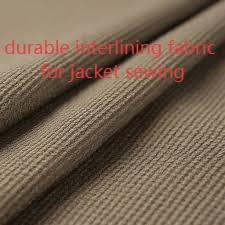In modern garment production, the hidden layer known as Interlining often decides whether a piece holds its shape or sags after a few washes, and careful selection of Interlining during the design phase prevents many fit and durability problems later on. This article explores material selection, attachment methods, testing protocols, and sustainability strategies that help designers and manufacturers deliver clothing that looks and feels superior over time.
Understanding the silent structural layer
That internal support is responsible for collar roll, lapel definition, and the crisp edge of a well-made jacket. It stabilizes seams and prevents distortion in areas of frequent stress like cuffs and waistbands. Designers who recognize its role treat it as an active ingredient in the recipe for quality, not an afterthought tucked away until production.
Material options and trade-offs
Support fabrics range from soft, flexible substrates to firm, structured weaves. Some are engineered to bond under heat; others are intended for sew-in applications where selective placement is required. Natural fiber blends provide a softer hand and breathability, while synthetic alternatives often deliver superior dimensional stability and moisture resistance. The choice depends on the outer fabric, intended use, and laundering expectations.
Attachment methods and manufacturing implications
Bonded systems speed up assembly and reduce labor costs, but they demand tightly controlled heat, pressure, and dwell times to avoid visible puckering or adhesive bleed. Sewn-in techniques offer repairability and a different aesthetic but increase production time. Hybrid approaches — bonding large areas while stitching high-stress points — can combine speed and durability when parameters are documented and controlled.
Practical testing and quality assurance
Validated sample protocols prevent expensive surprises after scale-up. Simulated washing and drying cycles, abrasion assessments, and adhesion strength tests for bonded systems reveal how pairings will behave in real life. Tracking changes in hand, dimensional stability, and peel strength gives production teams confidence that approved samples will translate reliably on the line.
Comfort, thermal behavior, and wearer experience
The inner layer affects thermal feel and movement as much as structure. Dense supports add warmth and firmness, desirable in overcoats, while lightweight supports preserve breathability in shirts. For activewear, elasticity and recovery are paramount; the support must move with the body without permanent deformation. Balancing structural requirements with tactile comfort prevents garments from feeling stiff or overly heavy.
Sustainability and end-of-life considerations
Environmental impact is increasingly central to specification decisions. Options that favor recyclable fibers, water-based adhesives, and supports designed for easy separation at end-of-life make garments more recyclable. Reducing offcuts through efficient nesting and choosing supports compatible with fabric recycling streams help close material loops. Prioritizing repair-friendly supports also extends product life and reduces waste.
Design-to-production collaboration
Early collaboration between design, materials, and production teams avoids mismatches. Prototyping sessions that pair candidate supports with outer fabrics reveal interactions such as differential shrinkage or surface change before bulk orders are placed. Documenting heat, pressure, dwell time, and adhesive type in a shared recipe ensures consistent replication during manufacturing ramp-up.
Maintenance, repairability, and consumer value
Supports that permit local repair or replacement add tangible consumer value. For investment garments, the ability to refresh an internal layer can extend useful life dramatically. Clear consumer care instructions and serviceable construction reduce returns and reinforce brand reputation for quality and longevity.
Small-batch and artisanal strategies
Smaller producers benefit from keeping a narrow palette of proven supports and a compact set of validated fabric pairings. Running representative pilot batches and maintaining a sample library of tested combinations reduces trial-and-error and shortens development cycles. Strong supplier relationships provide consistent materials and technical backing when volumes increase.
Final thoughts: making hidden choices visible in product quality
Although not visible on the hanger, the internal support layer determines much of what consumers perceive: fit, drape, comfort, and durability. Treating this component as a design parameter — selecting materials thoughtfully, applying them with controlled methods, and validating through testing — turns it from a hidden necessity into a competitive advantage. For practical reference on types, bonding techniques, and application examples, visit https://www.interlining-factory.com/news/what-is-interlining-types-applications-and-more.html
